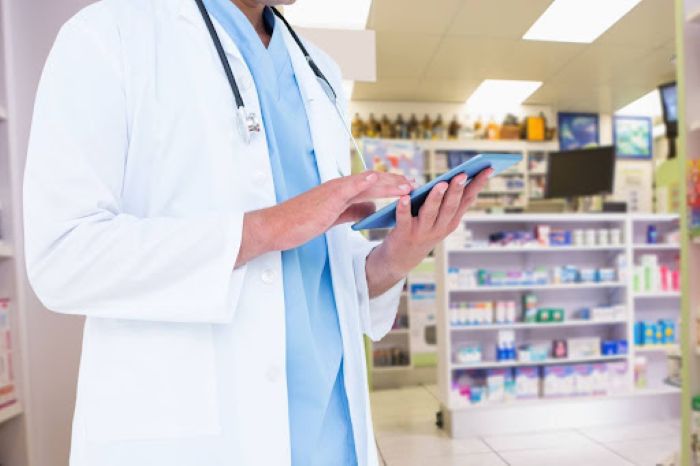In the current fast-paced world of healthcare pharmacies play an essential part in ensuring that patients receive medicines in a safe and timely manner. To keep up with demand to reduce errors and improve customer satisfaction, many pharmacies are using the latest technology.
In this blog, we’ll explore how pharmacies are becoming more efficient through digital transformation–covering inventory management, automation, data analytics, telepharmacy, and more.
Leaders in the field, such as Raman Bhaumik, demonstrate how modern pharmacy operations thrive when guided by vision and expertise. As a respected healthcare executive and the owner of Texas Star Pharmacy, Raman’s commitment to operational efficiency, process improvement, and patient-centered care reflects the direction in which the industry is moving. Her background in pharmacy management and advanced leadership training highlights how strong governance and innovative thinking can accelerate digital transformation across pharmacy settings.
Table of contents
- Streamlined Inventory Management
- Automation in Dispensing and Filling
- Cloud-Based Pharmacy Management Systems
- Data Analytics and Predictive Insights
- Digital Patient Engagement
- Telepharmacy
- Regulatory Compliance and Fraud Prevention
- Integrated Healthcare Ecosystems
- The Role of AI and Machine Learning
- The Future: Mandates and Partnerships
- Key Takeaway
Streamlined Inventory Management
Efficient inventory management systems are crucial for the operation of pharmacies. Manual systems that were in use in the past may cause overstocking or stockouts and expired drugs that negatively impact the profits of the pharmacy as well as patient health care. Today, pharmacies are utilizing digital inventory platforms made up of barcode scanners to provide live tracking and automated notifications for reorders.
Key Benefits:
- Reducing Waste: Automatic expiration-date tracking decreases the quantity of stocks that are damaged.
- Improved Cash Stream: The only things that are needed are items ordered in accordance with the forecasts for demand.
- Greater Quality: Barcode scanning decreases the risk of human error during dispensing.
These systems not only improve supply chains but also ensure compliance with rules for controlled substances. Data-driven inventory tools help pharmacies anticipate demand, particularly during flu season and health emergencies.

Automation in Dispensing and Filling
Automation technology such as robotic dispensing equipment and automated packaging for medications has transformed pharmacies. These technologies drastically reduce the manual labor involved, improve the speed of dispensing, and reduce the number of mistakes made by human beings.
Use Cases Include:
- Automated Prescription Fillers: Automated devices manage the packing and counting process so that pharmacists can concentrate on interacting with patients.
- Tablet Counters and Label Printers: Automated devices improve the speed of operation and also ensure precision.
- Central Fill Pharmacies: Large-scale facilities are able to handle large quantities of prescriptions for various outpatient clinics, making use of conveyors, robots and conveyor belts.
In addition to efficiency improvements, automation also improves security. If pharmacists don’t take medication they are able to review prescriptions and give information to patients. This is essential to avoid adverse drug reactions.
Cloud-Based Pharmacy Management Systems
Cloud-hosted services are creating new levels of interoperability as well as accessibility. These systems are centralizing EHRs (EHR) and billing, adjudication of insurance, and enabling tools to facilitate communication with patients.
Advantages of Cloud Solutions:
- Unrestricted Access: Pharmacists have the ability to examine records and edit profiles online.
- Real-time Collaboration: The information is immediately shared among hospitals, clinics or franchises.
- Flexible Infrastructure: There’s no need to install expensive servers on site, as well as incur IT costs.
- Security: Secure encryption coupled with backup protocols to protect the privacy of patients’ data.
More advanced systems also integrate e-prescription functionality, allowing prescriptions to flow directly from doctors to pharmacies–eliminating paper-based delays.
Data Analytics and Predictive Insights
Big data could change the game in the pharmacy industry today. Through the study of transactional, prescription and demographic data, pharmacies will find important information such as
- Demand Forecasting: Forecast seasonal spikes and new health concerns.
- Monitor Adherence to Treatment: Monitor those who are not receiving refills at the appropriate time, and promptly notify them.
- Improved Clinical Performance: Find out about interactions between medications as well as the consequences of adverse side effects in all demographics.
- Efficiency of Operations: The objective is to find the operational bottlenecks and eliminate the waste in operations.
These insights empower pharmacy managers to make data-driven decisions, optimizing both care quality and financial performance.
Digital Patient Engagement
Today, pharmacies aren’t just dispensing centers. They’re active in the treatment of patients. Digital touchpoints, such as mobile applications like chatbots, automated SMS, and secure messaging — strengthen the position of pharmacists.
Examples of Engagement Tools:
- Refill Reminders: Automated notifications notify patients to refill their prescriptions when it’s time to. Fill their prescriptions.
- Chat Service: Virtual assistants give information on dosage directions or other side effects.
- Medication Trackers: Apps keep track of daily intake and connect to prescription systems for monitoring.
- Health Consultations via Telehealth: Meetings online with pharmacists assist in the management of chronic illnesses and offer counseling.
Engaging in digitally-based engagement can build trust, increase compliance with medications, and help position pharmacies as convenient points of healthcare.
Telepharmacy
Telepharmacy lets pharmacists reach out to areas that are not served through remote consultations with virtual technology, and drug providers can provide remote help. With audio video conferencing and secured messaging options, pharmacists can:
- Verify prescriptions provided by satellite or remote dispensaries.
- Conduct sessions on the treatment of patients who are at home.
- Support teams are available in stores in off-peak hours or in the event of staff shortages.
This model extends knowledge in the field of pharmacy beyond physical locations and ensures the same high-quality of care regardless of the place of the clinic.
Regulatory Compliance and Fraud Prevention
The necessity of ensuring conformity with regulations set by the government and to avoid fraud is an essential aspect of pharmacies. Technology solutions could help with:
- Controlled Substance Monitoring: Real-time logs and automatic obligatory alerts.
- Audit Trail: Complete records for each prescription, user interaction and event that requires dispensing.
- The Adjudication of Insurance: Automated checks aid in preventing fraud in billing and lower the likelihood of denials on claims.
- ID Verification: The technology guarantees the identity of the patient as well as assists in preventing misuse.
Websites like Pharmaknowl can showcase tools specifically focused on compliance, demonstrating how software can assist pharmacies in complying with the law with ease and complete documentation.
Integrated Healthcare Ecosystems
The times of a single pharmacy are rapidly dissolving. Today’s successful pharmacies are part of a connected ecosystem where labs and clinicians and hospitals, as well as payers exchange information in a seamless manner. This is how technology can aid the connections.
- APIs Interoperable Platforms: Software systems are connected to EHRs as well as wearable devices and exchange health information.
- Virtual Care Networks: The course of a patient’s health from the hospital stay, as well as rehabilitation and pharmacy visits is accessible to healthcare professionals at any time in real-time.
- Collaboration Plans for Treatment: The doctor will be able to determine the patients’ compliance with prescribed protocols and adjust the treatment plan in line with that.
- Valuable Care: Alignment Pharmacy plays a part in health indicators that affect the population. This is a crucial component of the current health contract.
The Role of AI and Machine Learning
Artificial Intelligence (AI) isn’t something new, but it is currently being utilized in pharmacies. The most important applications include:
- Prescription Errors: Algorithms identify the presence of any dosage irregularities or potential dangers with prescription drugs before filling prescriptions.
- Predictive Inventory: Machine learning studies the patterns of use in the past to increase the quantity of stock.
- Customized Medical Program: AI analyzes patient data to tailor therapy plans or pinpoint possible issues in adhesion.
As AI expands, it will provide more individualization and better processes for pharmacies.
The Future: Mandates and Partnerships
What’s next in the world of pharmacies? You can expect an increase in:
- Blockchain: The supply chain offers complete transparency from end to end, especially for specific pharmaceuticals.
- IoT Gadgets: Pill bottles that have sensors that track refills and opening times.
- Pharma Alliances: Collaboration with telehealth companies as well as health technology startup companies.
- Lawful Innovation: Pilot programs are designed for remotely monitored surveillance as well as electronic credentials.
Platforms like Pharmaknowl allow pharmacies to meet new requirements in a seamless manner, providing seamless integrations, while in addition, they support the new standards.
Key Takeaway
Technology is revolutionizing the way pharmacies function, from simple inventory tracking, to artificial intelligence-powered prescription tests. Every investment in digital technology doesn’t just increase efficiency, but it also increases the security of patients as well as the satisfaction of patients.
Pharmacists will be able to devote more time to individualized treatment and counseling of patients rather than performing manual tasks.











